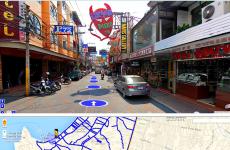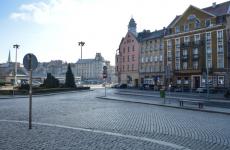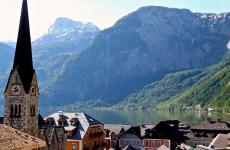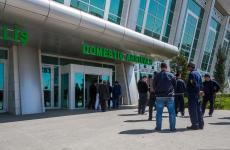Memorial to the victims of the disaster above Sinai. A garden in memory of the victims of the Sinai plane crash was opened in Vsevolozhsk
Exactly three years ago, an Airbus A320 plane crashed over the Sinai Peninsula, carrying Russian tourists from Egypt to their homeland. All passengers and crew members died before reaching home. Among the dead were 25 children, including a small resident of Gatchina Darina Gromova, which the Russians called the Main Passenger. Authorities in several countries are still investigating the causes of the plane crash. In terms of the number of victims, the disaster is the largest in Russian aviation. But nothing can bring back innocent people. the site remembers the victims of the disaster and the chronology of events over the Sinai Peninsula
Developments
The plane of the Russian airline Kogalymavia arrived in Sharm el-Sheikh on the eve of the tragedy. On October 30, he performed two passenger flights on the route Sharm el-Sheikh - Samara - Sharm el-Sheikh. The commander of the aircraft, Dmitry Zhigalkovich, and co-pilot Yuri Yushko later said that the flight took place as usual, and no problems arose in the air. On October 31, the airliner came under the control of 48-year-old commander Valery Nemov and 45-year-old co-pilot Sergei Trukhachev. Nemov had more than 12 thousand hours of flight practice under his belt, almost 4 thousand of which were at the controls of an Airbus A321. The plane passed technical control at Sharm el-Sheikh airport and took off safely.
Photo: flight path of flight 7K-9268 / flightradar24.com
Charter flight 7K-9268 route Sharm el-Sheikh - St. Petersburg was supposed to arrive in the Northern capital at 12:10, a little more than five hours into the flight. At 06:50 Moscow time, the plane took off from the Egyptian airport and headed along the coast of the Gulf of Aqaba. After 12 minutes, the aircraft turned left on a course of 340° to cross the Sinai Peninsula. When the board rose to a height of 9411 meters, its speed began to drop sharply. According to the website Flightradar24, at 06:13 the Airbus A320 began to lose altitude at a speed of 30 m/s. At approximately 07:14, flight 7K-9268 crashed in the central part of the Sinai Peninsula. The wreckage of the plane was scattered over a radius of 13 km. The total search area for the bodies of the dead and the remains of the airliner was 30 km. All 224 passengers died.
The first reports about the disappearance of the airliner from radars appeared in the Russian media at about 10:20 Moscow time. Initially it was reported that communication was interrupted near the Cypriot city of Larnaca. International publications Reuters and Sky News, citing their own sources, reported that the flight crashed. At this time, relatives of passengers begin to be notified about the loss of the airliner. People, hoping for a miracle, go to Pulkovo to meet a delayed flight. Charter 7K-9268 was still listed on the information board, which reported a ten minute delay.
“I was just at the airport that day and found people waiting for the plane. I was flying to study then, and I had problems getting my luggage. I arrived, but that flight did not. I remember the number of this plane on the board with the red inscription “detained”. I had just left the airport when literally 15 minutes later the crash was announced. A few hours later, photographs from the airport began to appear online. I look, and there are all these people, many of whom I saw at the entrance, or at Starbucks, or somewhere else. People who came to wait for their relatives"
Soon the hopes of the relatives were dashed: Egyptian authorities reported that the wreckage of the plane was found 50 km from Nehel, in the province of North Sinai. The airport management, together with the Federal Air Transport Agency, set up mobile medical headquarters. People were provided with psychological assistance. The emergency headquarters began work. Rescuers constantly informed relatives. But the latter were already beginning to understand that their relatives could no longer be returned.
 Photo: wreckage of flight 7K-9268 / life.ru
Photo: wreckage of flight 7K-9268 / life.ru Investigation
When information about the crash was confirmed, the Ministry of Emergency Situations sent five special aircraft to Egypt to deliver the bodies of the victims to their homeland. The black boxes, which were practically undamaged, were found on the day of the tragedy. The decryption was carried out by the Egyptian side. Representatives from six countries took part in the investigation: Russia, Egypt, the USA, Germany, France and Ireland. The commission also included consultants from Airbus.
The wreckage found 13 km from the crash site gave rise to claims that the plane was destroyed in the air. In this regard, versions began to appear about a possible explosion of the plane. Moreover, the possibility of both a bomb explosion in the cabin and a missile strike from the ground could not be ruled out. However, Egypt called any versions premature and unsupported by facts. On November 16, the head of the FSB, Alexander Bortnikov, said that the plane exploded as a result of a terrorist attack. On the bodies of the passengers, security forces found remains of explosives not produced in Russia. The Egyptian authorities assured that they would take the FSB study into account, but did not draw any conclusions. One of the groups controlled by ISIS (an organization banned in Russia) took responsibility for the terrorist attack. An examination of the wreckage of the airliner showed that the bomb exploded within rows 30-31. Presumably it was laid at site 31A. However, in September 2016, experts said that the bomb was hidden in the tail of the plane among baby strollers.
 Photo: wreckage of flight 7K9268 / vebus.ru
Photo: wreckage of flight 7K9268 / vebus.ru Until now, the authorities of the African country have not opened a case under the article “Terrorism”. In July 2017, a source close to Russian-Egyptian negotiations on aviation security told RIA-Novosti that Egypt does not want to investigate the case under the article “Terrorism” in order not to pay compensation to the relatives of the victims. In this case, it will become clear that the disaster occurred due to shortcomings of the local security services.
Victims
224 people died from the explosion, burns and falling from a great height. On board were mainly Russian citizens - 219 people. Also, four citizens of Ukraine and one citizen of Belarus were flying back from vacation. The oldest victim was 77 years old, the youngest was only 10 months old. 48 people who did not return home were from the Leningrad region. On November 1, 2015, mourning was declared in Russia, which lasted three days. In the Leningrad region, all entertainment events have been canceled until November 4.
Among the dead were children, grandchildren, husbands and wives, fathers and mothers. Many of the passengers posted photos online before the flight. Some flew to Egypt with their family, some to celebrate their wedding anniversary, and some to propose to their girlfriend. There were also those who went on vacation abroad for the first time. But no one was destined to return to their home.
The most famous publication is a photograph of the daughter of the Gromov couple. Little Darina flew with her parents to warm Egypt for the first time. The girl’s mother, Tatyana Gromova, captioned the photo “Main Passenger.” Under this name, the recording spread throughout the world and became a symbol of the tragedy. Darina was the smallest passenger on the plane. Her body was found 35 km from the crash site.
Spouses Olga and Yuri Shein flew to Egypt to celebrate ten years of marriage. They took three children with them: 11-year-old Zhenya, 10-year-old Lena and 3-year-old Nastya. A few minutes before landing, Olga posted a photo of her husband and her youngest daughter on her VKontakte page. The caption to the photo reads: "We're flying home." Sheina will never see her home.
 Photo: personal archive of Olga Sheina
Photo: personal archive of Olga Sheina Armen Vishnev flew to Egypt to celebrate his birthday. A few days before the tragedy, on October 26, he turned 27 years old. He worked in the Federal Customs Service near St. Petersburg, in Pushkin. Armen's mother told reporters that in one of his last messages he urged her not to get bored. Armen promised to bring a souvenir with him.
Volkhov resident Dmitry Bogdanov took his children, 10-year-old Anton, 22-year-old Nastya and 24-year-old Lera, to the sea for a vacation. The mother of a large family died of cancer several years earlier. The children wrote on their pages on the social network “Goodbye, Russia!”, “Goodbye, cold Russia” and “Rainy St. Petersburg, good-bye.” They will never see their homeland again.
The young couple Alexandra Chernovaya and Evgeny Yavsin went on their first joint trip abroad. A surprise awaited Alexandra on vacation: Evgeniy specifically saved money for trips to propose to his beloved at sea.
 Photo: personal archive of Alexandra Chernova
Photo: personal archive of Alexandra Chernova Evgenia Murashova from Pskov died in the disaster. She flew to Egypt with her mother Irina Pikaleva. Evgenia has an 8-year-old daughter at home. A few days before her tragic death, she posted an audio recording on her page entitled “I know I won’t come back.”
 Photo: screenshot from Ekaterina Murashova’s page
Photo: screenshot from Ekaterina Murashova’s page Along with all these innocent people, hundreds of others died. Hundreds, if not thousands, of relatives were left with broken hearts. Many of them still have not been able to identify their loved ones, which means they keep a grain of hope in their hearts. The unidentified remains of victims of the Sinai disaster were buried in a mass grave at one of the memorial cemeteries in St. Petersburg.
Memory
On Rumbolova Mountain in Vsevolozhsk on the second anniversary of the “Garden of Memory” tragedy. The project was financed from the regional budget and the budget of Vsevolozhsk. The names of all the dead passengers of flight 7K-9268 are immortalized on a granite slab. Also on this day, all the bells of the churches of St. Petersburg will strike 224 times, in honor of each person who died.
 Photo: “Memory Garden”
Photo: “Memory Garden” On October 28, the monument “Folded Wings” was unveiled in St. Petersburg. The memorial was erected at the burial site of unidentified Airbus passengers. 25 white balloons were launched into the sky, symbolizing the children who died in the disaster.
 Photo: “Folded Wings” / Administration of St. Petersburg
Photo: “Folded Wings” / Administration of St. Petersburg Every year, events in memory of the victims of the Sinai disaster are held throughout the country.
After the tragedy, activists created the Flight 9268 charitable foundation. The fund is supported by the administration of the Leningrad region, the administration of St. Petersburg, the Russian Union of Rescuers and the Kuznetsov Guild. In February 2016, with the assistance of the foundation, more than 80% of the families of relatives of the victims wrote in support of the idea of building a temple and monument in memory of the dead passengers and crew of flight 9268. The Church of the Great Martyr Demetrius of Thessalonica will be built in the Baltic Pearl multifunctional complex.
 Photo: Draft design of the Church of the Holy Great Martyr Demetrius of Thessalonica in the Baltic Pearl multifunctional complex / flight9268.ru
Photo: Draft design of the Church of the Holy Great Martyr Demetrius of Thessalonica in the Baltic Pearl multifunctional complex / flight9268.ru Cold piercing wind, wet snow. And about 200 people in front of the new monument are relatives of those who died in the crash of Kogalymavia flight 9268. They can be recognized by the flowers in their hands and the tears that freeze on their eyelashes.
FLY AND LAND
A banner with photographs of 224 people who soared into the sky over Sharm el-Sheikh, but will never return home. Military band. A corridor made of slabs cast from Corten steel. There are 224 names carved on them.
In the center are three stainless steel cylinders, a kind of improvised organ. On windy days there will be a hum here, reminding you that the plane is about to fly and land.
Next to the memorial there is an alley of very thin maples. It seems that they are tied to pegs, connected by a single thread. Just like the people who were connected by this terrible day. There are 107 maples, one tree for each orphaned family. We wanted to seat 224, but there wasn’t enough space.
Opposite, across the path, there are 25 small green Christmas trees, a reminder that 25 children became victims of the airliner crash.
The memorial was laid exactly a year ago. On September 6, 2016, the government of the Leningrad region chose the option of a monument to the victims of the Sinai plane crash from 28 presented options. The winner was the project “Garden of Memory”. And now, a year later, the garden turned green.
LIVING MEMORY
At the opening of the monument, Russian Transport Minister Maxim Sokolov expressed gratitude to the Governor of the Leningrad Region, Alexander Drozdenko, and officials for providing all possible support to “those who will now be remembered for the rest of their lives.” He announced the beginning of a minute of silence.
“We are opening not just a memorial, but an alley of living trees, a reminder of those whose lives were interrupted. They were flying happy, they wanted to talk about their vacation...,” Alexander Drozdenko interrupted the silence.
We are opening not just a memorial, but an alley of living trees, a reminder of those whose lives were interrupted. They were flying happy, they wanted to talk about their vacation..., - interrupted the silence Alexander Drozdenko.
The governor of the 47th region noted that in the garden of memory everyone will be able to sit down and relax, because benches are installed on the alley, and the memorial is illuminated. Relatives will be able to plant their own tree here and take care of it.
“The graves are scattered in different places, but here, at this memorial, relatives will be able to gather,” he added. - Memory is the main thing we have.
Chairman of the Social Policy Committee Alexander Rzhanenkov took the floor.
“Our sacred task is to remember,” the official noted. “And do everything possible to prevent this from happening again in the future.”
CREATIVITY, MOMENT AND ETERNITY
The founder of the Flight 9268 charity foundation, Valery Gordin, who lost his son Leonid over Sinai, could barely contain his emotions.
“It’s been two years since they told us at Crown Plaza that they weren’t there,” Gordin recalled. - We realized that life would no longer be the same as before. I had to learn to live with this memory. We have united. And it helped... Memory is needed not only by relatives: we used to be like you, but we all walk under the same sky. And God grant that this cup passes by everyone.
Amalia Vishneva, the mother of 27-year-old customs inspector Armen Vishnev, who died in a plane crash, presented a book in memory of “The Eternal Footprint of Light.” The woman held the first copy in her hands. On the cover there are clouds, a stopwatch and a feather as symbols of eternity, the moment and creativity.
The 456-page book, which the Leningrad region authorities helped publish, consists of photographs and poems dedicated to the victims. For each - a U-turn. In total, the book contains 170 authors, including 40 poems written by relatives and friends of the victims.
“In the first ten days of 2016, we counted more than one and a half thousand poems dedicated to the tragedy over the Sinai,” said Vishneva. - Every word is like a tear...
PATH TO HEAVEN
“Hopelessness, emptiness... It seemed that we would not be able to live on, but the whole country responded to the tears,” said Oksana Fedorova, who lost her parents Alla and Alexander Radlevich in Egypt, at the monument. – This garden will bloom and live, just like our memory.
Bishop Ignatius of Vyborg and Priozersk performed a prayer service at the memorial and sprinkled the monument with holy water. Relatives crossed themselves, sobbing. Someone kissed the portraits of their dead loved ones they had brought with them.
The opening of the monument was marked by the launch of 224 white balloons into the air, which symbolized innocent souls who had gone to heaven. Some balls clung to the trees, as if not wanting to leave.
Finally, relatives and officials laid flowers at the monument. All 224 names were read out over the monument.
Exactly two years ago, on October 31, 2015, the most massive air crash in terms of the number of deaths occurred in the entire history of Russia. On this day, an Airbus A321-231 airliner of a Russian airline took off from Sharm el-Sheikh, Egypt, and headed for St. Petersburg. The crew of the airliner was operating a charter flight and was taking Russian tourists home after a vacation.
The plane climbed calmly along the Gulf of Aqaba and would soon cross the Sinai Peninsula to enter European airspace. However, at the 23rd minute of the flight, communication between ground services and the aircraft was interrupted. It soon became clear that the Airbus A321-231 crashed to the ground in the central part of the Sinai Peninsula and was completely destroyed. The wreckage of the aircraft was scattered over 13 km. All 224 people on board the plane were killed.
At the time of the death of the airliner, there were seven crew members and 217 passengers. Of these, four were Ukrainians, one was Belarusian, and the rest were Russian citizens. Among them was the deputy head of Pskov and a deputy of the local legislative assembly. According to the Federal Air Transport Agency, the oldest passenger was 77 years old, and
the youngest victim of the tragedy was a 10-month-old.
Shortly before the tragic incident, her mother Tatyana published a photo of the child on a page on the VKontakte social network. The photo shows the girl standing on the windowsill of an airport window with her back to the viewer. She looks at the planes on the ground. She captioned the photo: “The most important passenger.”
This photograph was later circulated by many Russian and world media and became a symbol of the Sinai disaster. Diana's mother and father also died as a result of the plane crash.
The Russian President, as well as the leaders of many countries in Europe and the world, expressed condolences to the victims. The day after the plane crashed, mourning was declared in Russia. However, the French published three cartoons on the topic of the disaster, which caused a negative reaction from the Russian Federation and. In response, the French Foreign Ministry stated that “in France, journalists freely express their opinions,” while “it does not always coincide with the official position of the French authorities.”
“There were no questions about the car”
Soon after the incident, various versions of what happened began to be put forward. Almost immediately, the hypothesis that the plane crashed due to a pilot error was dismissed. The crashed Airbus was controlled by experienced pilots, and the crew commander, 48-year-old Valery Nemov, had flown over 12 thousand hours, of which more than 3860 were on the Airbus A321.
However, details of the aircraft’s operation soon became known, and it turned out that it was far from new.
It was released in the spring of 1997 and made its first flight on May 9. After this, the aircraft was transferred to the American company International Lease Finance Corporation (ILFC), which by May 27 leased it to the Lebanese airline Middle East Airlines (MEA), which had owned it for six years. On June 2, 2003, already under tail number TC-OAE, the airliner was leased to the Turkish airline Onur Air. This structure later sub-leased the aircraft to Saudi Arabian Airlines, and from July 30 to September 29, 2010 to Syrian Cham Wings Airlines. By the spring of 2012, the TC-OAE board returned to ILFC, and by March 30, 2012, it was leased to the Russian Kogalymavia.
On April 30 of the same 2012, it was bought from ILFC by the Dutch airline AerCap, which re-delivered this airliner to the Russian Kogalymavia. The Russian airline, in turn, has already been operating under the Metrojet brand since May 1, 2012.
During the long service of the aircraft, an unpleasant incident occurred from a safety point of view. On November 16, 2001, he was flying passenger flight ME 306 on the Beirut-Cairo route and during landing at the airport in the Egyptian capital, the pilots raised his nose too high, causing the tail to drop so low that it hit the ground. None of the 88 people on board the plane (81 passengers and 7 crew members) were injured then, and the airliner itself returned to passenger routes after undergoing repairs. This information was confirmed by representatives of Kogalymavia, assuring that the aircraft passed all the necessary checks and technical tests on time.
On the eve of departure, the ill-fated flight underwent maintenance, and the receiving crew had no questions about the car.
Interrupted message
An investigation into the causes of the tragedy was launched by several large structures from around the world, since Egypt is a very popular tourist destination among citizens of many countries. The investigation was carried out by the Egyptian Ministry of Civil Aviation, the Russian Civil Aviation Safety Investigation and Analysis Bureau of France, the German Federal Bureau of Aircraft Accident Investigation, the Irish Air Accident Investigation Department, and the US National Transportation Safety Board.
At the same time, in accordance with international law, general management was carried out by Egyptian investigators, since the incident occurred in the airspace of that country. Already on the first of November, the previously found “black boxes” from the lost liner were deciphered. In the meantime, he opened criminal cases under Articles 263 and 238 of the Criminal Code of the Russian Federation (“Violation of traffic safety rules and operation of railway, air, sea and inland water transport and the subway” and “Production, storage, transportation or sale of goods and products, performance of work or provision of services that do not meet security requirements").
The UK and German airlines also interrupted flights with the Egyptian state, and France, the Netherlands and Belgium warned their citizens against flying to Sharm el-Sheikh. In addition, it announced the cancellation of night flights to Sharm el-Sheikh.
Customers not identified
Meanwhile, the victims in the disaster case filed a class action lawsuit against the tour operator, Kogalymavia airline and insurance companies for a total amount of about €1.4 billion. This is the first example of a class action lawsuit for such a serious amount in Russian history.
And although the involvement of Kogalymavia employees in the incident over Sinai is not confirmed by facts, in the spring of 2016 it banned domestic and international flights of this airline.
According to the most frequently voiced version, the Sinai division of the terrorist “” (both organizations are banned in Russia) was behind the terrorist attack. Its members accepted responsibility for this crime shortly after the fact.
However, there are other points of view. A number of experts believe that the Qatari organization Ansar Beit al-Maqdis (a cell of the Islamic State banned in Russia) could be behind the terrorist attack. The United States also announced its trace in the tragedy.
Be that as it may, after the death of the plane, Russian aviation began to intensify air strikes against targets of various Islamist organizations in Syria. For the first time, Russian strategic aviation was involved in raids on IS targets and other extremists.
However, the names of the specific perpetrators of the terrorist attack have not yet been established.
And on October 28, 2017, a monument to the victims of the disaster was unveiled at the Serafimovskoye cemetery in St. Petersburg. In addition, among St. Petersburg residents there is an idea to erect a monument to 10-month-old Darina Gromova, which a famous sculptor has already promised to make for free.





